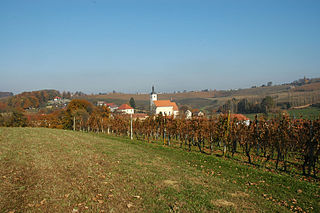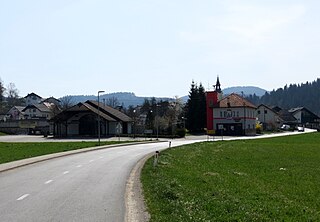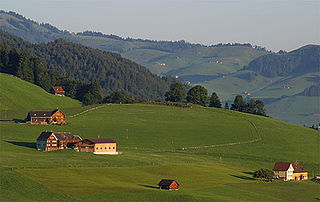
Prebold is a settlement in central Slovenia. It is the seat of the Municipality of Prebold. It lies on the edge of the lower Savinja Valley at the northern edge of the Sava Hills west of Celje. The area was part of the traditional region of Styria. The municipality is now included in the Savinja Statistical Region.

Miklavž na Dravskem Polju is the largest settlement and the seat of the Municipality of Miklavž na Dravskem Polju in northeastern Slovenia. It lies on the right bank of the Drava River southeast of Maribor. The area was part of the traditional region of Styria. It is now included in the Drava Statistical Region.

Sveti Tomaž is a settlement in northeastern Slovenia. It is the seat of the Municipality of Sveti Tomaž. It lies in the Prlekija Hills and was part of the Municipality of Ormož until 2006. The area traditionally belonged to the region of Styria. It is now included in the Drava Statistical Region.

Rovt pod Menino is a dispersed settlement in the hills south of Šmartno ob Dreti in the Municipality of Nazarje in Slovenia. Traditionally the area belonged to the Styria region and is now included in the Savinja Statistical Region.

Miklavž pri Ormožu is a settlement in the hills northeast of Ormož in northeastern Slovenia. The area traditionally belongs to the Styria region and is now included in the Drava Statistical Region.

Turje is a settlement in the hills southeast of Dol in the Municipality of Hrastnik in central Slovenia. Traditionally the area was part of the Styria region. It is now included with the rest of the municipality in the Central Sava Statistical Region.

Sveti Lovrenc is a village in the Municipality of Prebold in east-central Slovenia. The area is part of the traditional region of Styria. The municipality is now included in the Savinja Statistical Region.

Sveti Jernej is a village in the Municipality of Slovenske Konjice in eastern Slovenia. The area is part of the traditional region of Styria. The municipality is now included in the Savinja Statistical Region.

Sveti Štefan is a small settlement in the Municipality of Šmarje pri Jelšah in eastern Slovenia. It lies in the hills south of Šmarje in the Kozje region. The area is part of the traditional region of Styria. The municipality is now included in the Savinja Statistical Region.

Brecljevo is a settlement in the Municipality of Šmarje pri Jelšah in eastern Slovenia. It lies in the hills south of Šmarje. The area was traditionally part of Styria. The municipality is now included in the Savinja Statistical Region.

Vinski Vrh pri Šmarju is a small settlement in the Municipality of Šmarje pri Jelšah in eastern Slovenia. It lies in the hills south of Šmarje. The area is part of the historical Styria region. The municipality is now included in the Savinja Statistical Region.

Močle is a village in the Municipality of Šmarje pri Jelšah in eastern Slovenia. It lies in the hills west of Šmarje. The area is part of the historical Styria region. The municipality is now included in the Savinja Statistical Region. It is a clustered village on the south side of a gentle slope. It includes the hamlets of Erpoge and Sveti Lovrenc.

Orehovec is a settlement in the Municipality of Šmarje pri Jelšah in eastern Slovenia. The area is part of the historical Styria region. The municipality is now included in the Savinja Statistical Region.

Jakob pri Šentjurju is a settlement south of Šentjur in eastern Slovenia. The area is part of the historical region of Styria. The Municipality of Šentjur is now included in the Savinja Statistical Region.

Šentvid pri Planini is a village east of Planina pri Sevnici in the Municipality of Šentjur in eastern Slovenia. The area is part of the historical Styria region. The municipality is now included in the Savinja Statistical Region.

Primož pri Šentjurju is a settlement in the Municipality of Šentjur in eastern Slovenia. The area is part of the historical Styria region. The municipality is now included in the Savinja Statistical Region. The settlement includes the hamlets of Bozne, Brezne, Grabne, and Kote.

Štefan pri Trebnjem is a small village in the Municipality of Trebnje in eastern Slovenia. It lies on the left bank of the Temenica River just west of Trebnje. The area is part of the historical region of Lower Carniola. The municipality is now included in the Southeast Slovenia Statistical Region.

Šent Jurij is a village in the Municipality of Grosuplje in central Slovenia. The area is part of the historical region of Lower Carniola. The municipality is now included in the Central Slovenia Statistical Region.

Šentpavel na Dolenjskem is a settlement just east of Šentvid pri Stični in the Municipality of Ivančna Gorica in central Slovenia. The area is part of the historical region of Lower Carniola. The municipality is now included in the Central Slovenia Statistical Region. It includes the hamlets of Grumlof, and Mandrga.

Videm pri Ptuju is a settlement in the Municipality of Videm in eastern Slovenia. It is the administrative centre of the municipality. The area traditionally belonged to the Styria region. It is now included in the Drava Statistical Region.



















